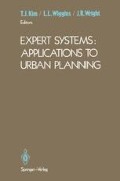Abstract
Site selection is a critical decision making element for a wide range of economic activities, from land use planning to residential location selection by individuals. Typically, site selection involves two phases. First, a small number of alternatives among all possible sites are identified for further evaluation. Then these selected alternatives are examined in depth to find the optimal site. Because of the effort required for a thorough evaluation of each site, the number of sites included in the second stage is, by necessity, small. Therefore, the first phase of the site selection process is very important because if, for example, the “best” available site is not included in the set of alternatives selected for thorough study, then this site can never be selected as the optimal site. In large scale planning the first phase involves reconnaissance and prefeasibility studies. At the individual level, it may involve consultation with a specialist.
The Original version of this chapter was published in Expert Systems in Civil Engineering, Proceedings of a Symposium of the American Society of Civil Engineers, M.L. and C.N. Kostem (eds), April 8–9, 1986, pp. 182–192
Access this chapter
Tax calculation will be finalised at checkout
Purchases are for personal use only
Preview
Unable to display preview. Download preview PDF.
References
Addelman, S., 1962a. “Orthogonal Main-Effect Plans for Asymmetrical Factorial Experiments”, Technometrics, Vol. 4, pp. 21–26.
Addelman, S., 1962b. “Symmetrical and Asmmetrical Fractional Factorial Plans”, Technometrics, Vol. 4, pp. 47–59.
Fiegenbaum, E.A., 1983. “Knowledge Engineering: The Applied Side”, in Intelligent Systems, J.E. Hayes and D. Michie, eds., Ellis Horwood Limited, Chichester, England.
Findikaki, I.T., 1980. “Residential Location Preferences: A Conjoint Analysis Approach”, Engineer Thesis, Stanford University.
Findikaki, I.T., 1982. “Conjoint Analysis of Residential Preferences”, PhD. Dissertation, Stanford University.
Fishbein, M., 1967. “A Behavior Theory Approach to the Relations between Beliefs about an Object and the Attitude towards the Object”, in Readings in Attitude and Theory Measurement, M. Fishbein ed., John Wiley and Sons, New York.
Johnson, Richard M., 1974. “Trade Off Analysis of Consumer Values” in Journal of Marketing Research, Vol. XI, May, 1974.
Lewin, K., 1951. Field Theory in Social Sciences, Harper and Row, New York.
Michie, D., S. Muggleton, C. Riese, S. Zurbrick, 1984. “Rulemaster: A Second Generation Knowledge-Engineering Facility”, First Conference of Artificial Intelligence Applications, Denver, December 5–7.
Quinlan, J.R., 1979. “Discovering Rule by Induction from Large Collection of Examples” in Expert Systems in the Micro Electronic Age, D. Mitchie ed., Edinburgh University Press.
Rosenberg, M.J., 1956. “Cognitive Structure and Attidunal Affect”, Journal of Mathematical Psychology, Vol. 4, pp. 1–20.
Tversky, A., 1976. “A General Theory of Polynomial Conjoint Measurements”, Journal of Mathematical Psychology, Vol. 4, pp 175–201.
Wolpert, J., 1965. “Behavioral Aspects of the Decision to Migrate”, in Papers of the Regional Science Association, Vol. 15, pp. 159–169.
Editor information
Editors and Affiliations
Rights and permissions
Copyright information
© 1990 Springer-Verlag New York Inc.
About this chapter
Cite this chapter
Findikaki, I. (1990). SISES: An Expert System for Site Selection. In: Kim, T.J., Wiggins, L.L., Wright, J.R. (eds) Expert Systems: Applications to Urban Planning. Springer, New York, NY. https://doi.org/10.1007/978-1-4612-3348-0_7
Download citation
DOI: https://doi.org/10.1007/978-1-4612-3348-0_7
Publisher Name: Springer, New York, NY
Print ISBN: 978-1-4612-7976-1
Online ISBN: 978-1-4612-3348-0
eBook Packages: Springer Book Archive

